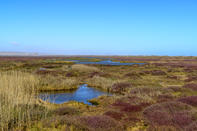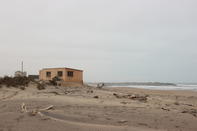History in the Making
Alexander Bay in the north-west part of the Northern Cape province, was put on the map in 1927 when Dr Hans Merensky discovered diamonds on an ancient marine terrace near to the town. This remote little town is situated where the longest river in South Africa, the Orange, flows into the stormy, icy Atlantic Ocean.

With a small supermarket, cafes, guesthouses and even the odd restaurant, this quaint town of Alexander Bay has its own unique character and is well worth a visit.
Diamonds have been mined along this section of coastline since 1925, but fortunately, the wetlands on the Orange River estuary have been declared a Ramsar site (The Convention on Wetlands), thus remaining relatively unspoiled.
Outdoor adventure opportunities abound in Alexander Bay, with hours of pleasure waiting for mountain bikers and cyclists. Hiking has also become increasingly popular because of the low impact on the environment, as well as an increased appreciation of the local fauna and geology.
A Ghost Town

Alexander Bay was named after Sir James Alexander who planned to become rich exporting copper. He was the first person to map the area during an 1836 expedition into Namibia for the Royal Geographical Society. For a passing moment, the town of Alexander experienced prosperity until the 1870s, whereafter the town assumed a ghost town status until 1927. Following the 1925 discovery of diamonds along the West Coast, followed by diamonds and oysters discovered on an ancient marine terrace at Alexander Bay.
Alexander Bay's entire stretch of coastline was closed up until Port Nolloth. A result of this diamond rush was the Diamond Coast rebellion of 1928 where fortune hunting, diamond-hungry prospectors threatened an armed uprising that police then quelled. To this day, the State runs the mine Alexkor Limited. Another picture in one’s mind’s eye is that of copper ore bound for export markets being shipped through the Richtersveld in barges down the Orange River. That was another scene that played out in this region’s fascinating history.
 The town of Alexander Bay (Alexanderbaai in Afrikaans) in the Northern Cape, takes its name from Sir James Alexander, who dreamed of making ...
The town of Alexander Bay (Alexanderbaai in Afrikaans) in the Northern Cape, takes its name from Sir James Alexander, who dreamed of making ...